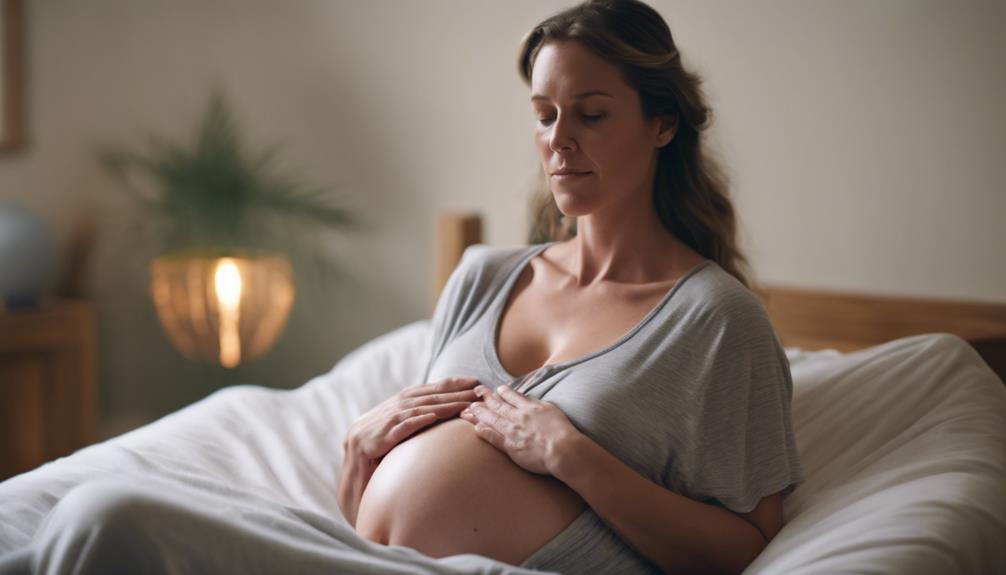
Revealing the enthralling story behind the evolution of pain-free hypnobirthing uncovers a fascinating journey of women reclaiming their birthing experiences. From its inception by Marie Mongan to the integration of cutting-edge neuroscience, the history of hypnobirthing is a tapestry woven with empowerment and resilience. As we explore the origins, techniques, and tools that have revolutionized the childbirth landscape, a profound sense of curiosity arises. How did hypnobirthing transform from a niche practice to a global movement, reshaping the way women approach one of life's most transformative moments?
Origins of Hypnobirthing Techniques
In exploring the origins of hypnobirthing techniques, we enter a domain where hypnosis, deep breathing, visualization, and meditation intertwine to provide a peaceful approach to alleviating labor pain and anxiety. Marie Mongan, the founder of the HypnoBirthing Institute, introduced this childbirth education method in 1989, emphasizing a natural birth process rooted in deep relaxation techniques. The aim of HypnoBirthing is to enable women to have a pain-free and fear-free birth experience by reframing perceptions of labor and delivery.
Hypnobirthing classes, based on Mongan's principles, teach women how to enter a state of deep relaxation, use self-hypnosis for pain management, and visualize a smooth and gentle childbirth. The term 'contractions' is often replaced with 'uterine waves' in HypnoBirthing to foster positivity and empowerment during labor. Initially gaining popularity in the UK and Europe, this approach gradually made its way to the US, where more individuals are embracing natural birthing methods and seeking out Hypnobirthing as a way to approach childbirth with confidence and calmness.
Evolution of Hypnobirthing Practice
With the passage of time and increasing recognition in the field of childbirth education, the evolution of Hypnobirthing practice has seen a notable integration of modern neuroscience principles. Originally rooted in hypnosis for pain management during childbirth, Marie Mongan developed the HypnoBirthing program in 1989, emphasizing relaxation techniques and fear release. This approach includes deep breathing, visualization, and reframing labor experiences to promote unmedicated births and empower women to embrace their innate birthing capabilities.
Hypnobirthing classes teach women to enter an altered state of consciousness, allowing for a focused and relaxed birth experience. As the practice gained popularity in the UK, Europe, and the US, it became known for promoting calm and gentle childbirth experiences. The evolution of Hypnobirthing reflects a holistic approach to childbirth, combining traditional relaxation methods with advancements in neuroscience to support women in achieving a positive and empowering birth journey.
Tools for Reducing Fear in Labor

The foundation of Hypnobirthing techniques lies in equipping expectant mothers with tools that effectively diminish fear and anxiety during the labor process, paving the way for a more serene and empowering birthing experience. Women who used hypnobirthing methods often describe feeling more in tune with their bodies, allowing them to embrace the natural childbirth process with less fear and more confidence.
By participating in hypnosis groups and learning techniques like deep breathing, visualization, and meditation, expectant mothers can reframe their perception of labor and birth, viewing contractions as 'uterine waves' and letting their bodies work harmoniously to bring their babies into the world.
Research has found that women who practice hypnobirthing tend to experience less pain and anxiety during childbirth, leading to a more positive overall birthing experience. Partner involvement in hypnobirthing can further enhance the effectiveness of these tools, creating a calm and supportive environment for the laboring mother. Through these methods, hypnobirthing empowers women to approach childbirth with a sense of peace and confidence, fostering a deeper connection to the birthing process.
Promoting Positive Birthing Experiences
To cultivate positive birthing experiences, Hypnobirthing employs relaxation techniques that aim to alleviate fear and anxiety commonly associated with childbirth. By incorporating hypnosis and relaxation techniques, Hypnobirthing helps women reframe their perception of labor terminologies, creating a more empowering and calm birth environment.
Research indicates that this approach may lead to a reduction in medical interventions such as cesarean sections and episiotomies. Women who use hypnosis during childbirth are also less likely to require pain-relieving drugs, highlighting the effectiveness of these techniques in promoting positive birthing experiences.
Additionally, involving partners in the Hypnobirthing process can enhance its impact, providing additional support and encouragement during labor. By focusing on relaxation, empowerment, and reducing anxiety, Hypnobirthing offers a holistic approach to childbirth that prioritizes the well-being of both the mother and the baby.
Empowering Women Through Hypnobirthing

Empowering women through the practice of Hypnobirthing involves harnessing the power of relaxation techniques and fear reduction to cultivate a positive and empowering childbirth experience. Marie Mongan's HypnoBirthing program, introduced in 1989, focuses on empowering women by teaching them to reframe their labor experiences, promoting relaxation, and providing them with more control during childbirth. This approach not only aids in reducing anxiety but also fosters a sense of empowerment among expectant mothers.
Hypnobirthing techniques, such as hypnosis, deep breathing, visualization, and meditation, help women alter their consciousness and maintain focus during labor.
Studies suggest that Hypnobirthing can notably reduce fear and anxiety during childbirth, leading to a more positive and empowering experience for women.
Women using Hypnobirthing have reported feeling less afraid and anxious during labor, highlighting the profound impact of relaxation and fear reduction on their overall labor experience.
Frequently Asked Questions
What Is the History of the Bradley Method?
The history of the Bradley Method dates back to 1947 when Dr. Robert Bradley introduced a natural approach to childbirth. Focused on promoting natural childbirth, the method emphasizes relaxation techniques, father involvement, breathing exercises, labor positions, and active birth.
It aims to empower women by providing tools for natural pain relief and fostering a positive birthing experience. The Bradley Method educates couples on preparing physically, mentally, and emotionally for childbirth, ultimately promoting a smooth and empowering journey.
Are Bradley Method Classes Worth It?
The Bradley Method classes offer valuable tools for those seeking natural childbirth. With a focus on partner involvement, relaxation techniques, and labor preparation, participants learn breathing exercises and pain management strategies.
The approach is well-regarded for empowering women through education and fostering a supportive birthing environment. High rates of unmedicated births and positive experiences indicate the effectiveness of Bradley Method classes, making them worth considering for those interested in a holistic approach to childbirth.
Can You Have Pain Relief With Hypnobirthing?
While Hypnobirthing doesn't guarantee a pain-free childbirth, it offers significant pain relief benefits through various techniques like self-hypnosis, visualization, and meditation. Success stories show a strong mind-body connection in managing labor pain, empowering women to have a more positive birthing experience.
Despite misconceptions, Hypnobirthing promotes natural childbirth by minimizing fear and maximizing relaxation, ultimately enhancing the overall childbirth journey for women.
What Is the Bradley Method of Pregnancy?
The Bradley Method of pregnancy emphasizes natural childbirth through relaxation techniques, partner involvement, and breathing exercises. It prepares women for labor by teaching relaxation responses and providing thorough childbirth education.
The method encourages a supportive environment for laboring women, aiming to minimize fear and pain during childbirth. By empowering women to trust their bodies and manage pain naturally, the Bradley Method promotes a positive and empowering birthing experience.
Conclusion
To sum up, the history of pain-free hypnobirthing has revolutionized the way women approach childbirth.
With over 95% of women reporting reduced pain levels during labor after practicing hypnobirthing techniques, the empowerment and confidence gained through this practice are undeniable.
By combining relaxation, visualization, and self-hypnosis, hypnobirthing has become a powerful tool for women to take control of their birthing experiences and approach labor with calmness and positivity.





